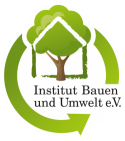As an associated project partner, the Institut für Bauen und Umwelt e.V. (IBU) has been supporting the Zukunft Bau research project PCR4PV since June 1st 2024, which aims to advance the further development of Product Category Rules (PCR) for Environmental Product Declarations (EPD) of PV applications as part of Zukunft Bau research funding under the leadership of the Fraunhofer Institute for Solar Energy Systems ISE.
The IBU and Fraunhofer ISE are cooperating on the research project, in particular to expand existing PCRs for the creation of EPDs for building-integrated photovoltaics (BIPV).
The overarching objective of the 24-month research project is the harmonization of PCRs for EPDs and the development of methodological approaches for the complete ecological assessment of PV modules, PV rooftop systems and BIPV over their lifetime. As an associated project partner, IBU is responsible for project-related consulting, the initial publication of the developed PCR and the development and verification of an average industrial EPD by a third party.
Research contract closes definition gaps and maps scenarios
The specific aim of the project is to develop extended product category rules for environmental product declarations for EPDs of PV modules and their applications in rooftop PV systems and building-integrated PV systems. In future, the PCRs should enable manufacturers to declare environmental information for these products objectively and comprehensively through EPDs and at the same time meet the requirements of the EU EcoDesign legislation currently in the development process and the Type 1 “Electronic Product Environmental Assessment Tool” (EPEAT) eco-label.
In addition to the effects of PV module production, the focus is on the utilization phase and the system balance. The latter includes those system components that are required for a PV system in addition to the PV modules. By producing electricity during the use phase, PV systems can overcompensate for their production-related environmental impact, which distinguishes them from most other products. The electricity yield and consequently the environmental impact of the life cycle of PV systems are influenced by various parameters. The PCRs developed here provide methodologies for the environmental assessment of PV modules themselves as well as for rooftop PV systems and BIPV systems (roof and façade).
The research work closes definition gaps of already existing PCRs on the PV module and system level.The PCRs in this project will be applicable for two scenarios: 1) each as a product-specific PCR under standardized conditions (PV module and system), 2) as a use-specific PCR for the evaluation of a specific installation (PV system).The first scenario allows a cross-manufacturer comparison without knowledge of a specific use, the second allows the derivation of the real environmental impacts in a specific application situation.
Before the PCR is published, Fraunhofer ISE and the IBU are planning an open consultation with selected stakeholders from industry and science responsible for EPDs for PV products and (integrated) PV systems in order to disseminate the results and subject them to a critical review. The transfer of results will primarily take place via the first publication of the developed PCR in the EPD database ÖKOBAUDAT.
Relevance of data for sustainable construction
The German government’s coalition agreement gives high priority to the sustainability of buildings and the associated ecological assessment. Certification systems such as the Assessment System for Sustainable Building (BNB) play an important role here.
The life cycle assessment of buildings and structures is already required by law in some other European countries; in Germany, public funding for sustainable buildings has now been installed for the first time with the QNG seal. In order to meet the requirements of these subsidies, it is important to be able to record all the environmental impacts of the products used over their entire life cycle. It is important that these environmental impacts are calculated on the basis of recognized and agreed rules.
The public database for this (ÖKOBAUDAT) does not yet have data for the PV module, PV rooftop system and BIPV system product groups selected in the project.
About the project partners:
Fraunhofer ISE is the largest solar research institute in Europe. Its more than 1,400 employees conduct research into a sustainable, economical, safe and socially just energy supply system based on renewable energies.
As the program holder for EPDs, the Institut Bauen und Umwelt e.V., with over 330 members, is the largest association of manufacturers in the building materials industry committed to sustainable building: With over 3,500 published EPDs, IBU and its members ensure that the ecological aspect can be included in the sustainability assessment of buildings.
Building technology as a future field for EPDs
While the underlying product data in the form of EPDs is already common practice for building material, building product and building component manufacturers for the life cycle assessment of buildings, LCA data for MEP is also becoming increasingly relevant on the market. The IBU is organizing a kick-off round table online on July 10th 2024 under the title Let’s Talk TGA & EPD and invites all interested parties.

